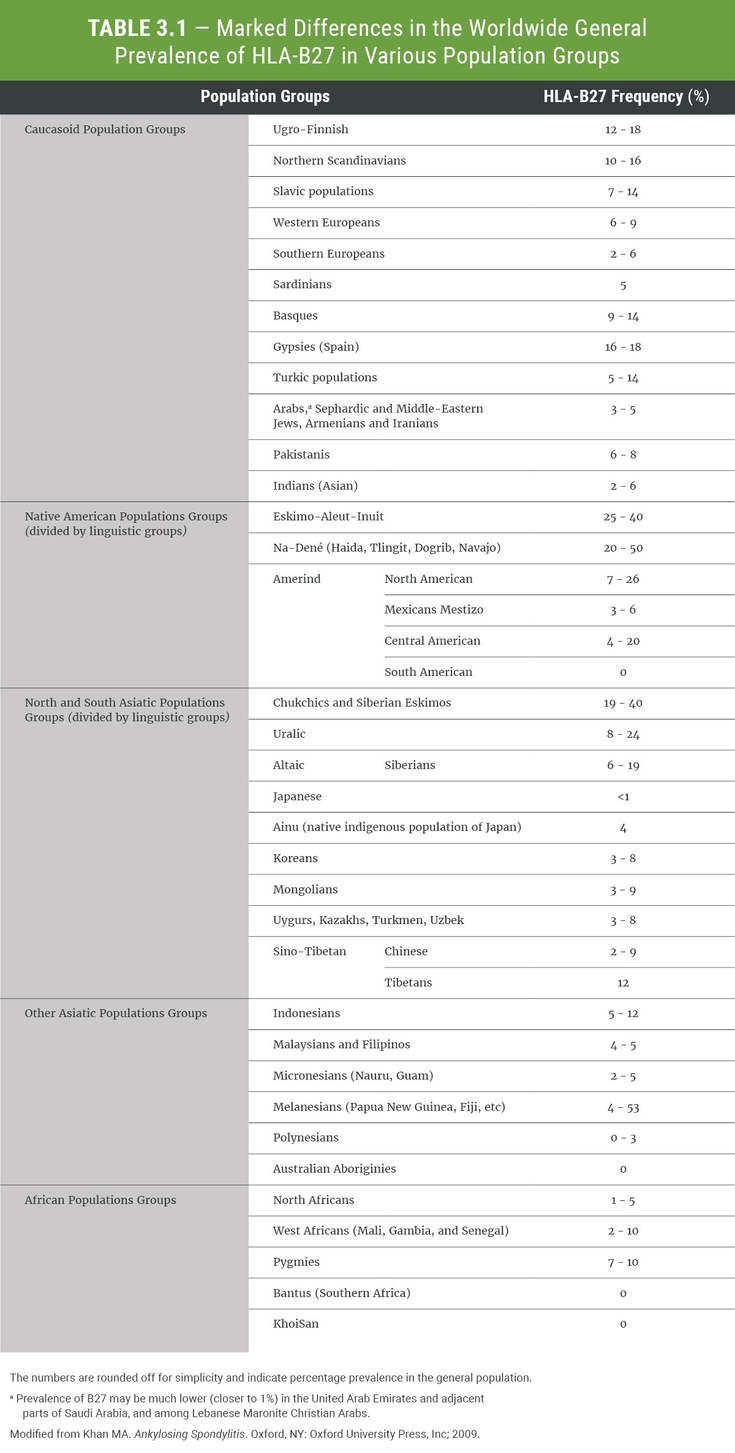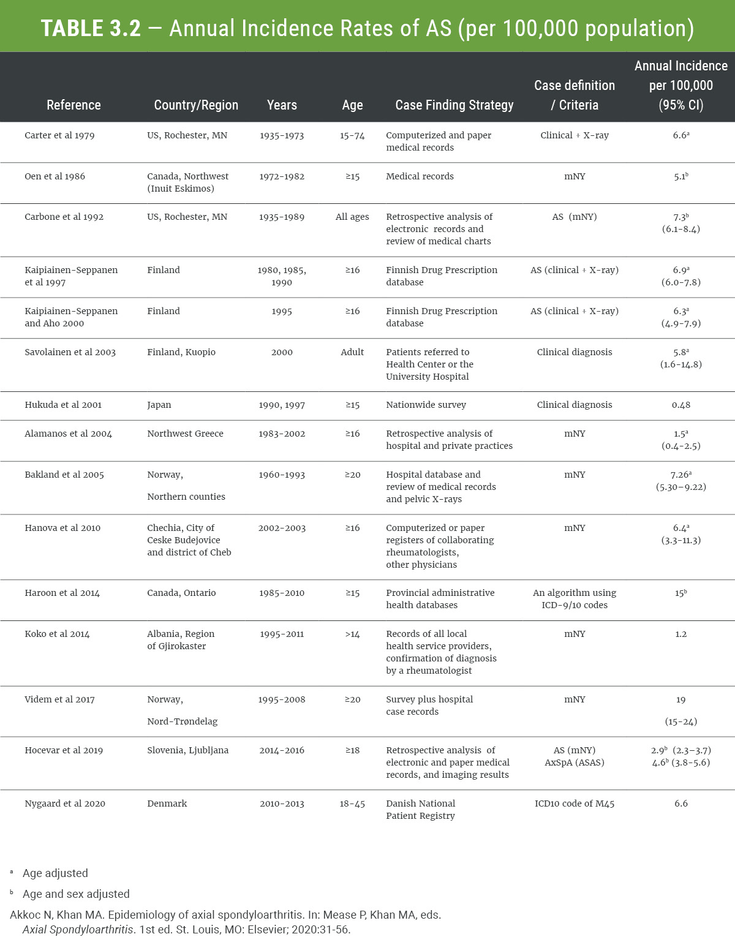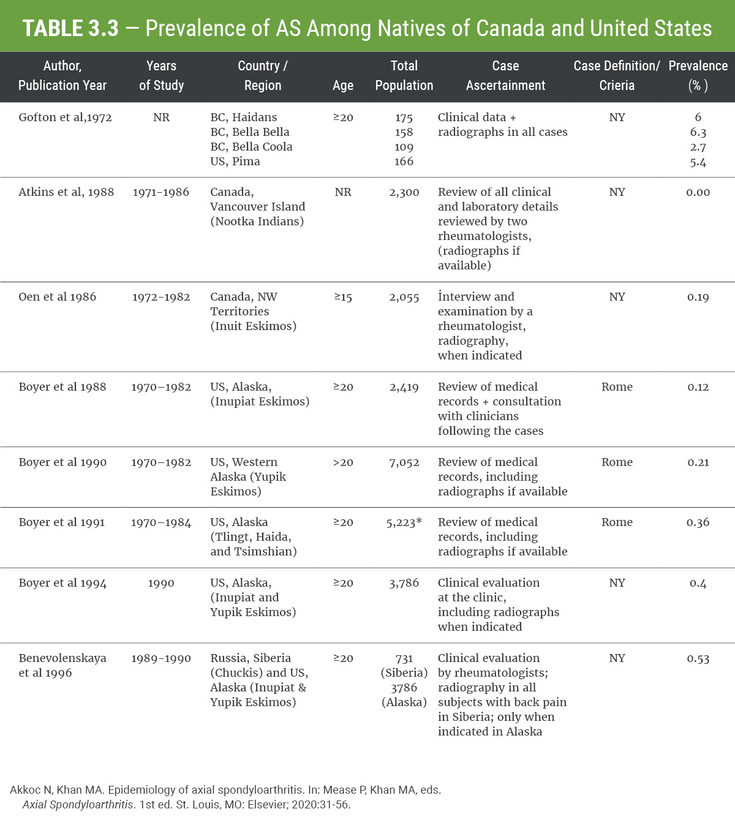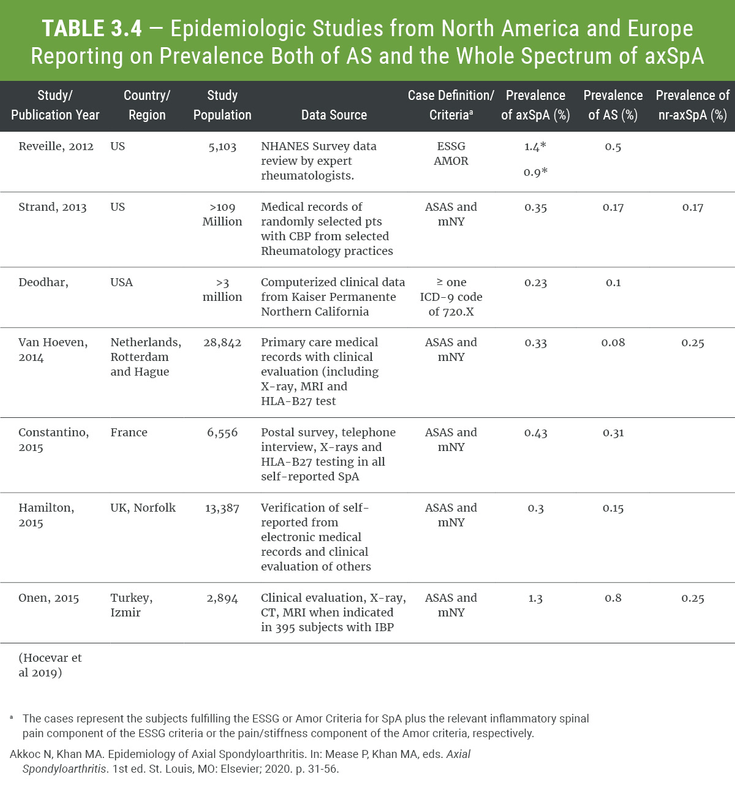Incidence and Prevalence
Introduction
It is necessary to know the frequency of a disease in a population to enable an estimate of its burden on the society, to allocate appropriate resources for its control and clinical utility of tests for its detection. The prevalence of ankylosing spondylitis (AS) has long been underestimated compared with that of rheumatoid arthritis (RA), partly because the earlier studies focused largely on well-established AS. This has changed, with the introduction of magnetic resonance imaging (MRI) as a reliable tool in detecting active inflammatory sacroiliitis and with better appreciation of the wider spectrum of the disease that includes non-radiographic axial spondyloarthritis (nr-axSpA). Recent epidemiologic studies have revealed that, axial spondyloarthritis (axSpA)/AS may be as common, if not more common, than RA, at least in some populations, but physicians’ perceptions are only slowly changing and numerous misconceptions remain.
Frequency of a disease is assessed by two…
To continue reading
Log in or register to continue reading. It's free!
OR
By signing up to create an account, I accept Healio's Terms of Use and Privacy Policy.
Introduction
It is necessary to know the frequency of a disease in a population to enable an estimate of its burden on the society, to allocate appropriate resources for its control and clinical utility of tests for its detection. The prevalence of ankylosing spondylitis (AS) has long been underestimated compared with that of rheumatoid arthritis (RA), partly because the earlier studies focused largely on well-established AS. This has changed, with the introduction of magnetic resonance imaging (MRI) as a reliable tool in detecting active inflammatory sacroiliitis and with better appreciation of the wider spectrum of the disease that includes non-radiographic axial spondyloarthritis (nr-axSpA). Recent epidemiologic studies have revealed that, axial spondyloarthritis (axSpA)/AS may be as common, if not more common, than RA, at least in some populations, but physicians’ perceptions are only slowly changing and numerous misconceptions remain.
Frequency of a disease is assessed by two types of measures: incidence and prevalence. Incidence is the number of new cases that develop over a period of time and conveys information on the risk of developing a disease for the concerned time period. In order to calculate a reliable estimate for a disease that is relatively infrequent, a large sample size with sufficiently long follow-up period is required. This can be also achieved by hospital-based studies by identifying diagnosed cases in a defined area, now made more feasible due to wide-spread electronic healthcare data collection. However, such studies cannot capture undiagnosed cases and underestimate the true disease incidence, and the inherent referral bias overestimate the disease severity. Moreover, incomplete medical records, misdiagnosed cases and improper hospital registration are potential factors that may impair the reliability of the reported incidence rates.
Prevalence is defined as the total number of existing cases at a given time point or period of time, and it can be accomplished by using a relatively modest sample sized face-to-face surveys. This method enables to capture undiagnosed cases in the population and to apply standardized criteria for case ascertainment, and therefore generate more accurate estimates as compared with hospital based studies. Disease occurrence reported in different studies may be affected by study designs and other methodologic issues that include data source, population structure, coverage of the target population, and case ascertainment criteria. The differences in the prevalence of HLA-B27 in the population (Table 3-1) as well as differences in environmental exposures and even the time of the study may also impact the disease frequency in different populations.
Incidence Studies
There are relatively fewer incidence studies of AS as compared to the prevalence studies and they are summarized in Table 3-2. Of interest, the two US studies conducted in Rochester, Minnesota, that had at that time a 99% white population of mostly Scandinavian descent reported very similar annual incidence rates for AS at 6.6 and 7.3 per 100,000 people at the two different time periods. Comparable incidence rates have been reported in North European populations. Recent studies from central part of Norway and the province of Ontario in Canada estimated higher incidence rates at 19 and 15 per 100,000 adult populations, respectively. These high incidence rates may be just a reflection of the increasing awareness of the disease over the years by physicians, particularly after the introduction of anti-tumor necrosis factor (anti-TNF) agents into clinical practice for the treatment of AS, as well as the changing attitude of physicians for the diagnosis of AS after the introduction of MRI as a sensitive tool for detecting sacroiliitis.
A recent epidemiologic study of axSpA from United States (US) rheumatology practices showed that it is not uncommon for physicians to make a diagnosis of AS, in the absence of any radiographic examination or despite the presence of negative radiographic findings for definite sacroiliitis. Moreover, physicians may be prone to making a diagnosis of AS in some patients with equivocal findings on pelvic radiographs, and only chronic (not active or acute) osteitis of the sacroiliac joints (SIJs) on MRI. Some healthcare providers may be particularly inclined to do so to meet insurance coverage criteria, when nr-axSpA is not an approved indication for the chosen therapeutic agent. Markedly lower incidence rates of AS were reported from southern European countries, but possibly due to weaknesses in their case finding strategies. As of now, only one study from Slovenia assessed the incidence of axSpA, as defined by the Assessment of Spondyloarthritis International Society (ASAS) criteria and noted an annual incidence of 4.6 per 100,000 population.
Information on the incidence of AS in non-western populations is scarce. A Japanese study reported a very low incidence (Table 3-2). This may be explained by the very low prevalence of HLA-B27 (0.5%) in their general population. The only other incidence study in a non-western population was conducted in Inuit Eskimos who have a high HLA-B27 prevalence (25%) and calculated an annual incidence rate of 5.1 per 100,000 population.
Prevalence Studies
There are far more prevalence studies than incidence studies across the world populations, as mentioned earlier. Notably, cross sectional population-based studies generate more reliable prevalence estimates since they can capture undiagnosed cases in the community and can apply standard classification criteria such as modified New York (mNY) criteria for diagnosing AS, or ASAS criteria when examining the prevalence of axSpA.
Dean and associates performed a systematic review and assessed all the published studies on the prevalence of AS until May 2012. They extracted the data from the population-based studies and collated them to calculate mean and weighted continent specific prevalence estimates. Importantly, they excluded hospital-based studies from their calculations due to their potential bias. They also excluded a highly cited German study conducted in blood donors because it used MRI scanning during the diagnostic process. They calculated mean prevalence of AS to be 0.24% (weighted mean: 0.18%) within Europe, 0.17% (mean weighted mean 0.18%) within Asia and 0.10% (weighted mean 0.12 %) within Latin America. Single population-based studies from North America and Africa reported the prevalence of AS, as 0.32% and 0.07%, respectively. Figure 3-1 and Figure 3-2 show the prevalence recorded in different population-based studies conducted in European and Asian countries, respectively. The mean ratio of male to female cases is 3.8:1 in Europe and 2.3:1 in Asia.
A subsequent systematic review and meta-regression analysis conducted by Stolwijk and colleagues reviewed the literature up until July 2014, and reported roughly similar continent specific AS prevalence estimates for Europe (0.25%), East Asia (0.16%), Latin America (0.14%), North America (0.20%) and Sub-Saharan Africa (0.02%) (Figure 3-3). The highest AS prevalence (0.35%) was found in Northern Arctic communities. This analysis included both population-based and hospital-based studies and reported also on the spondyloarthritis (SpA) prevalence in different subregions (Figure 3-3). Data indicate a large variation in the reported prevalence estimates, which can be explained in part by the prevalence of HLA-B27 in the general population. The clinical characteristics that were significantly associated with variation in disease prevalence included demographic characteristics (proportion of females, mean age of the sample, geographic area and the setting) as well as the methodologic characteristics (year of data collection, case finding and case ascertainment). Several other studies published on the prevalence of AS which all have been extensively reviewed in this module.
Highest prevalences in Europe have been reported by population-based studies. A very nice epidemiologic study among the population of Tromsø, a city in northern Norway that has a 16% prevalence of HLA-B27 in the general population (Table 3-1), reported the prevalence of AS to be between 1.1% to 1.4% (1.9% to 2.2% for males and 0.3% to 0.6% for females). There was no difference in HLA-B27 prevalence between men and women, but the disease appears to be milder in women. It was calculated that 6.7% of the HLA-B27(+) individuals and 0.2% of HLA-B27(-) individuals had AS, and that 22.5% of the HLA-B27(+) subjects with chronic back pain or stiffness had AS. The indigenous Samis (Lapps) population of the extreme northern region of Norway has even higher prevalence of HLA-B27 (24%) and AS (1.2%). The same is also true among all the native indigenous populations of circumpolar Arctic and sub-Arctic regions of Eurasia and North America. On the other hand, it is of great interest that HLA-B27 and AS are virtually absent among the genetically unmixed native (indigenous) populations of South America, Australia and in certain southern regions of Africa.
The prevalence of AS in Asia seems to be in the same order of magnitude with that in Europe. A pooled analysis of 38 epidemiologic studies from China and Taiwan that included 241,169 Han ethnic Chinese adults found a prevalence of AS to range from 0.2% to 0.54%. The prevalence of undifferentiated SpA ranged from 0.64% to 1.2% and it was 0.01% to 0.1% for PsA and 0.02% for reactive arthritis. Therefore, the overall prevalence of AS and related SpA among the Chinese ranged from 0.87% to 1.84%. In contrast, the prevalence of rheumatoid arthritis (RA) ranged from 0.2% to 0.93%, the highest rate being reported from a Taiwan urban area.
The highest observed HLA-B27 prevalence (50%) has been noted among the general population of Haida Indians living on Haida Gwaii (also known as the Queen Charlotte Islands) in British Columbia, a province of Canada. Not surprisingly, approximately 6% of adults (10% among men) in this population had definite AS in 1970’s (Table 3-3). Pima Indians, who have an 18% frequency of HLA-B27, have a 2% prevalence of AS among males. Studies in Inupiat (Inupiaq) and Yupik Eskimos with 25% and 40% prevalence of HLA-B27, showed a prevalence for any form of SpA (including AS) of 1.5% and 2.5%, respectively and the prevalence of AS was 0.4% among adults age ≥ 20 years. A Canadian study from Alberta using the provincial administrative health databases reported AS prevalence at 0.6% among the natives (First Nations) in that province vs 0.2% among the rest of the population. It is worth mentioning that psoriasis and PsA are rare in all of these genetically pure native populations.
The Rochester epidemiologic study covering the years 1935 through 1973 estimated that the point prevalence rate of AS to be 0.13% for the general population based on the fact that there were 68 surviving cases of AS among the 52,000 total population of Rochester in 1973). There was 0.4% prevalence in subjects aged 45 to 64 years, and this is clinically more relevant because it is uncommon for AS to begin after age 45. A report from US National Center for Health Statistics survey published in 1998 was incomplete and not very robust, but a later (2008) report estimated that the prevalence of AS and related SpA varies from as low as 0.35% (that did not include undifferentiated SpA) to as high as 1.3%. This suggests that AS and related SpA afflict anywhere from 0.6 million to 2.4 million adults in the United States. It is of interest that the same survey suggests that RA afflicts only 1.3 million adults, down from the previous estimate of 2.1 million.
The analysis of data from the National Health and Nutrition Examination Survey (NHANES) covering the years 2009 to 2010, has dealt with the epidemiology of chronic back pain, HLA-B27 and axial SpA. This study indicates that the overall national prevalence of IBP among US adults ages 20-69 years ranges from 5.0% to 6.0%. The overall prevalence of HLA-B27 in the US adults ages 20-69 years was reported to be 6.1%; and its estimated prevalence was 7.5% among non-Hispanic whites, which is more than two times higher than the prevalence in all other US races/ethnicities combined (3.5%).
Although it was possible to provide a prevalence estimate of HLA-B27 in Mexican Americans (4.6%), sample size limitations precluded making reliable prevalence estimates in other race/ethnicity subgroups in the United States. This study reported an AS prevalence of 0.5% based on the self-reported cases among the 5,013 participants of the survey. This figure should be taken with caution, considering that the false positivity rate of self-reported AS may be high. The same study estimated the prevalence of SpA to be 1.4% according to the ESSG criteria. and 0.9% according to the Amor criteria. These figures are frequently erroneously cited as representing the prevalence axSpA because of the title of the original article and also in a later review article by the same authors. But it should be stressed that ESSG and Amor criteria did not show a high specificity for axSpA, in the validation set of ASAS cohort (64 and 78%, respectively).
Strand and colleagues conducted a hospital-based study by reviewing medical records of 861 randomly selected patients aged 18 to 44 with chronic back pain from 101 participating rheumatology practices in US. This study calculated the nationwide prevalence of axSpA to be 0.7%, based on ASAS classification criteria and 0.67%, based on clinical diagnosis. The investigators also found identical prevalence estimates of 0.35% for AS (as defined by the mNY criteria) and 0.35% for nr-axSpA (as defined by the ASAS criteria). It is worth pointing out that agreement between the diagnosis of axSpA based on the ASAS criteria and that based on the physician’s judgment was low to moderate. About one fourth of the patients classified as axSpA did not have a clinical diagnosis. Most interestingly, considerable number of patients in this study were diagnosed with AS in the absence of radiographic examinations or in the presence of negative radiographic findings. This is one of the few prevalence studies that reported on the prevalence of axSpA (Table 3-4).
Another US study utilized the computerized International Classification of Diseases, Ninth Revision (ICD-9) of a nonprofit health delivery system serving over 3 million people in North California, to assess the diagnostic prevalence of axSpA. The case definition was based on many assumptions, and it included patients enrolled before the publication of the ASAS classification criteria for axSpA. Using their most sensitive case finding strategy based on a single physician diagnosis code for ICD-9 720.X, they found quite a low prevalence estimate for axSpA (0.23%). There are only limited number of studies that have evaluated the prevalence of axSpA, due to the recent development of the ASAS criteria and the inclusion of MRI and HLA-B27 as an entry criterion, which are not widely available in some countries. These studies are shown in Table 3-4.
With the increasing clinical recognition of AS, a recent study from the Canadian province of Ontario reports nearly tripled prevalence of AS over the past 2 decades. They had identified 24,976 Ontarians with AS. Age/sex standardized AS prevalence increased from 0.08% in 1995 to 0.21% in 2010. Men had higher prevalence than women, and a higher proportion of them were diagnosed at an earlier age. But the proportion of women with new diagnosis of AS has also been increasing, a trend that began around the year 2003. For example, the male/female prevalence ratio decreased from 1.70 in 1995 to 1.21 by 2010. In Switzerland, there has been a gradually progressive decline in male to female ratio among patients with AS/axSpA from 2.6:1 in 1980, down to 1:1 by the end of 2016, due to improving disease recognition, more so in women, and the wider use of the newer disease definition.
A recent study estimated the prevalence of IBP and SpA among employees in a university in Izmir, Turkey. The prevalence of inflammatory back pain (IBP) was 6.6% and 1.8% had SpA, whereas axSpA prevalence was 1.3% (0.5% of them had radiographic axSpA [AS] and 0.8% for nr-axSpA). An earlier epidemiologic study of 2,887 subjects aged 20 years or over from Izmir city, selected by cluster sampling, had found the age- and sex-adjusted prevalence of AS (defined by the mNY criteria) to be 0.49% for AS (95% CI 0.26-0.85). The prevalence of AS in men was 0.54% (95% CI 0.19-1.20) and 0.44% in women (95% CI 0.19-0.88). This study suggests a high prevalence (0.49%) of AS in an adult urban population from western Turkey, which equals that of RA in the same population. The overall prevalence of SpA defined by the European Spondyloarthropathy Study Group (ESSG) criteria was 1.05% (0.88% in men (95%CI 0.42-1.59) and 1.22% in women (95% CI 0.73-1.89). The minimal male predominance noted among AS patients disappeared among the whole group of patients with SpA.
Another institutionally defined population study aimed to assess the prevalence of SpA in reference to HLA-B27 among employees of a French national electricity and gas company. Among the respondents to a validated questionnaire for SpA sent by mail, 6,556 subjects with available DNA samples constituted the source population. All screening positive patients underwent a plain anterior-posterior pelvic radiograph and HLA-B27 testing. This study estimated a standardized prevalence of SpA of 0.43%, with 75% of the cases fulfilling the ASAS criteria for axSpA. In the same cohort, the prevalence of AS was found to be 0.31% based on the mNY criteria. All subjects included in this study were ≥57 years old.
A Dutch group aimed to determine the prevalence of axSpA based on ASAS criteria in patients with chronic low back pain. Although they did not present any estimate for the prevalence of axSpA, AS and nr-axSpA in the general population, it can be calculated from the data provided in their article; and these values are 0.69%, 0.12% and 0.57%, respectively. It should be underlined that these estimates refer to only the undiagnosed cases in the population. The same group, using the same methodology and partly in the same population, reported almost 50% lower rates for each entity. Notably, only about 20% of the patients in these studies were HLA-B27 positive, indicating that different classification criteria may identify different patient populations.
According to an old study based on patients who were attending general practice and primary care clinics in England, approximately 5% of chronic back pain sufferers “may have a mild form of AS that may never progress to definite ankylosis, but for whom treatment as if they had AS may be of benefit.” The most recent study from England used a validated self-completed questionnaire for inflammatory back pain (IBP) to screen primary care adult patients with chronic low back pain. All patients with IBP were invited to undergo further assessment including MRI scanning. This study reported that among primary care adult patients with chronic back pain, there is a 5.3% (95% CI 4.0, 6.8) prevalence for SpA as a whole, including a 1.3% (95% CI 0.8, 2.3) prevalence for axSpA, that includes 0.66% (95% CI 0.28, 1.3) prevalence for AS.
There are methodologic challenges in conducting epidemiologic studies in axSpA that may explain the reported disparate disease occurrence estimates (i.e. geographic or ethnic differences, use of different classification criteria, reporting crude or standardized rates). We can add that it has become quite difficult to interpret the data and review papers with increasing misuse of the term axSpA as equivalent to AS in the original articles or sometimes in the citing manuscripts. But we can conclude that the population-based epidemiologic studies from the United States and abroad indicate a much high prevalence of AS and related SpA than was previously realized.

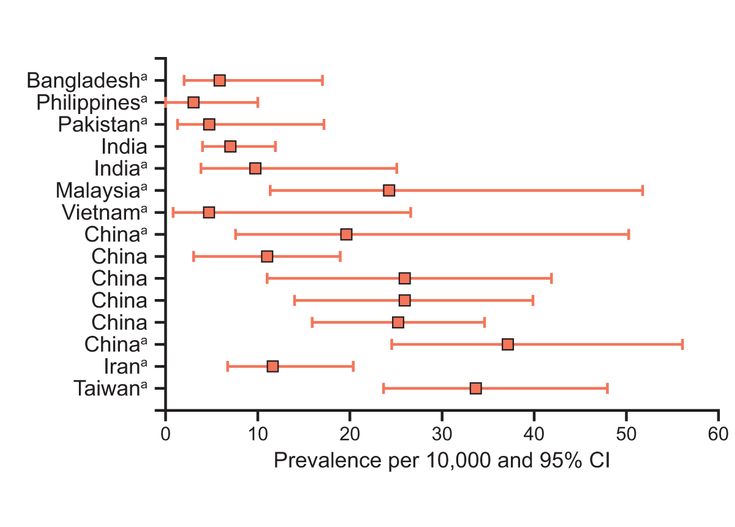

References
- Kahn MA, Akkoç N. Ankylosing Spondylitis— Axial Spondyloarthritis, 3rd ed. Professional Communications Inc. 2023
- Akar S, Birlik M, Gurler O, et al. The prevalence of rheumatoid arthritis in an urban population of Izmir-Turkey. Clin Exp Rheumatol. 2004;22(4):416-420.



